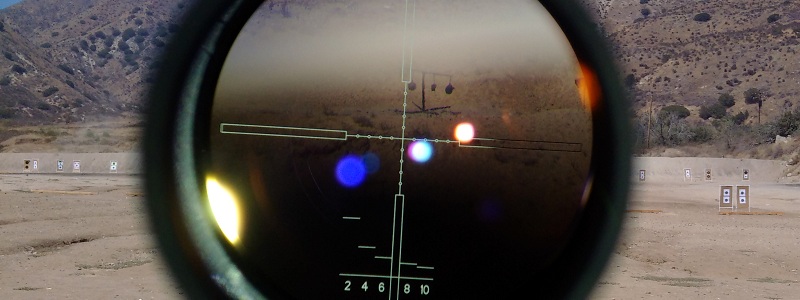Projects
We are making breakthrough changes in the
philosophy and design of telescopic sighting
systems. Below is a partial list of our innovation
projects pertaining to riflescopes and binoculars.
last update: September 2018
Project Eagle
Riflescopes and binoculars are based on the
concept of the Keplerian telescope. A Keplerian
telescope has an "exit pupil" which is located
behind the eyepiece lens. The user's eye must be
positioned at the the exit pupil in order to see
the full field of view. For binoculars, the exit
pupil is usually located 14 mm to 20 mm behind the
eyepice. For rifle scopes, this distance is
usually between 80 mm to 90 mm to prevent the
rifle scope eyepiece hitting the shooters' head
when the rifle is fired.

The existence of the exit pupil makes binoculars
and riflescopes difficult to use. (Try giving a
riflescope to a person who has never used them
before. The person will naturally hold the scope
in front of his/her eye but won't be able to see
anything through it!) Project Eagle provides a
radically new telescope concept wherein the exit
pupil is located at the eyepiece lens and is
virtually as large as the eyepiece diameter.
This makes it very easy to see the field of view
since there is no need for the eye to be
positioned at a precise location behind the
eyepiece.
In Project Eagle, a fiber optic face plate (FOFP)
is used to create an intermediate projected image
with diffuse illumination characteristics. The
FOFP enlarges the exit pupil to the size of the
eyepiece making eye-relief uncritical. In
riflescopes, it also eliminates the error known as
"parallax error".
Project Echo
In military operations, it is highly desirable to
have both a red-dot sight and a telescopic sight
available on the same weapon. This allows for both
near and far shots to be taken quickly. However,
mounting a red dot sight on top of a telescopic
sights causes a problem with head position on the
weapon. If the rifle's stock is configured to make
the shooter's eye aligned with the axis of the
telescopic sight, then the shooter must raise his
head to use the red-dot sight. This will destroy
his cheek weld and will adversely affect his or
her marksmanship capability.

Echo Project provide an elegant solution to the
above problem: A combination sight is designed
comprising a riflescope and a red dot sight such
that thy share a common eyepoint above the optical
axis of the riflescope. This allows the shooter to
engage near and far targets simply by changing his
"gaze angle" without moving his head on the stock.
Project Echo uses a refractive wedge prism to tilt
the viewing axis of the eyepiece upwards. The
prism is positioned at the eyepiece focal point or
after the last eyepiece lens depending on specific
embodiment of this invention.
Project Juliette
In traditional riflescopes, the point of aim
(POA) is adjusted mechanically using two knobs.
These knobs move the reticle inside the riflescope
in vertical and horizontal directions by a precise
amount to adjust for elevation and windage.
Project Juliette uses a radically different
approach: point of aim is adjusted optically using
the principle of refraction of light by thin wedge
prisms.

Project Oscar
Project Oscar is a variable magnification (zoom)
riflescope wherein adjusting the magnification
knob changes the distance in which the scope is
zerod-in. At low magnification, the scope is
zeroed-in for 100 m. As the magnification is
increased, the scope will automatically move the
zero distance further and further such that at
maximum zoom it is zeroed-in for 400m.
This makes it very easy for the shooter to aim at
targets at various distances. There is no need to
hold over the target or adjust the elevation knob.
As the shooter chooses the magnification to suite
the distance he is going to shoot at, the scope
automatically adjusts for bullet trajectory.

|
|
Milestones in Telescope Optics |
| 1604 |
Kepler presents Astronomiae Pars
Optica, setting the theoretical
foundations for Classical Optics. |
| 1608 |
The first telescopes (refractors) are made
in Holland by Hans Lippershey, Zacharias
Janssen, and Jacob Metius. Hans made the
first Binoculars later that year. |
| 1609 |
Galileo improves the telescope design by
adding a positive (concave) eyepiece. |
| 1611 |
Kepler improves on Galileo's design by
using a negative (convex) eyepiece,
providing greater eye-relief and a wider
field of view. Kepler's design remains the
basis for many modern scopes. |
| 1621 |
Snell independently discovers the
mathematical law of refraction, now known as
Snell's law. |
| 1637 |
Descartes publishes Dioptrique,
mathematically describing the conic forms
necessary for eliminating spherical
aberration. |
| 1665 |
Christiaan Huygens discovers Saturn's moon
Titan, having built his own telescope (the
Great Refractor) of 250 foot focal length!
The first study of Diffraction (coined by
Francesco Maria Grimaldi) supporting
Huygens's wave-theory of light is published
posthumously and goes largely unnoticed.
Newton performs his famous Prism experiments
from which he deduces that white light
itself is composed of a spectrum of colours,
and correctly distinguishes Chromatic and
Spherical Aberrations. However, based on his
corpuscular theory and experimental
observations, he argues it would be
impossible to eliminate Chromatic Aberration
in Refractors. |
| 1668 |
Isaac Newton makes the first successful
Reflecting telescope, providing such an
ingeniously simple and elegant solution for
the front-view obstruction problem (placing
a plane mirror at 45o) that it's hard to
believe it had eluded his predecessors for
over half a century! The Newtonian Reflector
becomes the defacto standard in Astronomy,
as scientists such as John Hadley and
William Herschel continuously pushed its
limits with increasing manufacturing
ingenuity.
Ironically, this came at the expense of
advancing the Refractor, as Newton's theory
of light rendered an explanation for
chromatic aberration that was inadequate for
understanding and thus further developing
the Refracting telescope. |
| 1758 |
John Dolland is awarded the patent for the
first achromatic lens � what Newton�s theory
of light had deemed impossible to create. |
| 1803 |
Thomas Young presents his two-slit
diffraction experiment to the Royal Society,
showing that light has wave properties. |
| 1817 |
Gauss invents the double-meniscus
telescope objective � a significant addition
to optical aberration correction technology.
This idea still forms the basis of modern
camera lens designs. |
| 1821 |
Fresnel mathematizes Young�s wave theory
of light, explaining Polarization,
Interference, and Diffraction effects in
general, overturning Sir Isaac Newton�s
corpuscular theory of light. |
| 1854 |
Ignazio Porro invents the modern Binocular
design, using prisms. |
| 1861 |
The American Civil War sees the invention
of a Galilean telescopic sight which could
be mounted on a rifle, thereby producing a
new class of infantry �the �sharpshooters� �
and launching an entirely new industry
around riflescope design and manufacture. |
| 1873 |
Ernst Abbe publishes the first
mathematical treatment of aberration,
diffraction and coma effects in the Carl
Zeiss Compound Microscope, paving the way
for Lens manufacturing to become a precision
engineering process, as opposed to an
exhaustive trial-and-error craft. |
| 1935 |
Alexander Smakula, at Carl Zeiss, invents
anti-reflective coating, leading to
significant image quality improvements and
what finally made compact Zoom lenses
possible. This singular innovation and its
subsequent refinement enabled the range of
modern telescopic sight developments for
cameras, binoculars, riflescopes, and the
backyard astronomer�s telescope, to name but
a few. |
| 1964 |
Donald Buris and John Maulbetsch are
awarded the patent for Variable Power
Riflescope with Tilting Reticle and Erector
Scope. The design and its variants represent
the last major innovation in modern scopes,
providing a mechanism for keeping a reticle
centered on an image that can also be
zoomed, and allows the operator to
independently adjust for windage and
elevation. |
|

